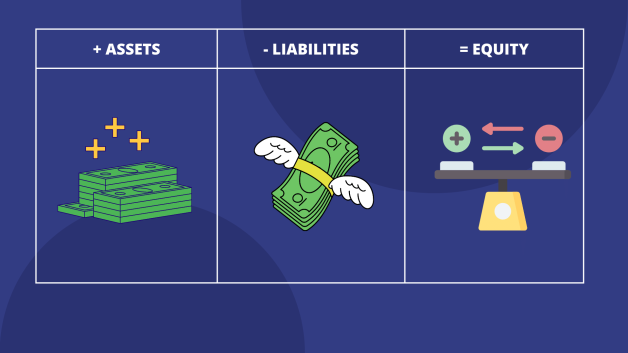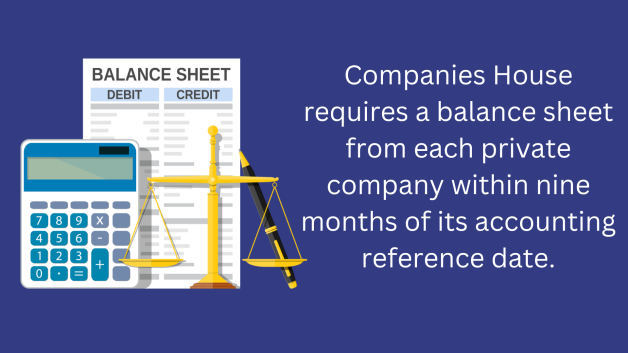A balance sheet is a key financial statement that provides a snapshot of a company’s financial position at a specific point in time. An alternative name for it is a ‘statement of financial position’. In accounting, balance sheets, along with income statements (also known as profit and loss statements) and cash flow statements are vital financial data used to assess a company’s financial health.
A balance sheet presents a summary of three of the company’s key variables:
- Assets
- Liabilities
- Equity
Ready to file micro-entity accounts?
Inform Direct provides a simple and efficient approach to the task of producing fully compliant micro-entity accounts for private companies limited by shares or guarantee.
These variables are governed by the equation Assets – Liabilities = Equity, which must always balance, hence the name ‘balance sheet’.
Equity is the company’s net worth to its shareholders. As the owners of the company, shareholders would stand to gain this amount if the company were liquidated and all its debts were paid off.
How is a balance sheet laid out?
In accounting software, the balance sheet typically shows two columns: assets on the left and liabilities and equity on the right. When presenting accounts to Companies House, the balance sheet is laid out vertically, with liabilities following assets. Two accounting periods (years) are shown: the finished year on the left and the previous year on the right.
How does a balance sheet work?
The balance sheet equation takes key variables and balances the equation by simple addition and subtraction. Here’s an example of how that works in practice.
How balance sheets work
1. Let’s consider the case of Bob, who starts a business and obtains a loan from the bank.
+
The cash from the bank goes into assets on the balance sheet.
–
But since he owes it to the bank, it also goes into liabilities.
=
These two amounts are equal and opposite, leaving equity unaffected.
——–
2. Bob buys office furniture with cash from the company’s assets.
+
The furniture becomes an asset.
–
The cash spent on it goes into liabilities.
=
Equity remains unaffected.
——–
3. The company makes regular monthly repayments to the bank.
–
These repayments are subtracted from assets.
+
Liabilities are reduced by the same amount, as a portion of the company’s debt to the bank has been repaid.
=
Equity stays the same.
——–
4. The company generates some sales.
+
The profits from these sales are recorded as retained earnings in equity.
+
Since these earnings are assets, they also go into the assets column.
=
Equity has changed, but the equation remains balanced.
What insights does a balance sheet provide?
A careful reading of a balance sheet can reveal:
1. Liquidity: whether there is enough liquidity to sustain current operations or if assets are tied up and might be consumed by liabilities.
2. Debt-to-Equity Ratio: how much the company has borrowed and whether the debt-to-equity ratio is healthy or dangerously high, aiding in assessing the amount of risk the company is exposed to.
3. Dividend Payments: the company’s ability or inability to pay dividends.
4. Current Liabilities: whether the firm can pay off its current liabilities.
5. Asset Value: the value of a company’s assets, providing insights into the potential recoupment of investments in the event of insolvency.
6. Asset Optimization: any “dead weight” assets that could be sold and reinvested in the business.
7. Further insights depending on the reader’s interests in the business.
When are balance sheets prepared?
Balance sheets are typically prepared at the close of an accounting period which can be monthly, quarterly or yearly. Companies House requires a balance sheet from each private company within nine months of its accounting reference date. For PLCs, the deadline is six months. The balance sheet is part of the annual accounts, a statutory filing requirement. Late delivery of accounts will result in a late filing penalty.
Companies House requires a balance sheet from each private company within nine months of the end of its financial year.
Who uses a balance sheet?
The balance sheet is used by various stakeholders who require insights into a company’s financial position, including:
1. Investors: It is one of the main documents investors want to see when a) assessing a business for investment and b) measuring its performance after investing.
2. Company Directors: will consult the balance sheet when reviewing performance and making strategic plans.
3. Lenders and Creditors: will use it to gain an overview of the company’s assets.
HMRC and Regulatory Bodies will also take a keen interest in the balance sheet.
Those experienced in reading balance sheets can quickly get a general idea of how the company is financed and the overall shape it’s in.
Now let’s look at the key elements of a balance sheet and how they are laid out.
Assets
Overall, an asset is anything owned or controlled by a company that has the potential to provide future economic benefits. On the balance sheet assets are divided into current assets and non-current assets.
Current assets
These are assets that are expected to be converted into cash or consumed within the current accounting period. Examples of current assets include:
- Cash and cash equivalents
- Accounts receivable
- Inventory
- Short-term investments.
Non-current (fixed) assets
Also known as long-term assets or fixed assets, these are longer-term assets that are expected to mature outside the current accounting period. Non-current assets include:
- Property, plant and equipment (land, buildings, machinery, vehicles)
- Intangible assets (patents, trademarks, copyrights)
- Long-term investments.
Liabilities
In the same way as assets, liabilities are grouped into current and non-current based on their expected timeframe for settlement. A few typical line items for a small company might be:
Current liabilities
- Accounts payable: money owed to suppliers
- Employee salary
- Short-term loans, due for repayment within one year
- Unearned revenue: payment received for goods and services that are yet to be provided
- Bank loans and overdraft
Non-current liabilities
- Long term loans
- Leases for buildings, vehicles and equipment
- Debt instruments that can be converted to equity or cash at a later date, e.g. convertible loan notes
Equity
Equity is also referred to as net assets, capital, shareholder equity, owners’ equity or net worth. It is what is left when liabilities are subtracted from assets. Equity represents the company’s net value and reflects the shareholders’ claim on the company’s assets. Equity can increase through profits generated by the business, further investments by shareholders, or a decrease in dividends paid out. Conversely, it can decrease due to losses incurred, dividend payments, or share repurchases.
Equity can include:
- Share capital
- Retained earnings
- Earnings from investments, foreign exchange transactions, etc.
- Share premium – money paid for shares in excess of their nominal value
- Money from profits allocated for specific purposes.
What can stakeholders calculate from a balance sheet?
The three categories described above – assets, liabilities and equity – constitute a company’s balance sheet and provide interested parties with a quick summary of its financial health. The figures found on it can be used to calculate a variety of key metrics for different purposes. These are often expressed as ratios. In addition to the debt-to-equity ratio mentioned above, the following are some examples of ratios that can be worked out from a balance sheet.
1. Current Ratio: This ratio assesses a company’s short-term liquidity and ability to meet its immediate obligations.
Current Ratio = Current Assets / Current Liabilities
2. Quick Ratio (or Acid-Test Ratio): Similar to the current ratio, the quick ratio measures a company’s ability to cover short-term liabilities using its most liquid assets. It excludes inventory from current assets, as inventory may not be easily convertible to cash in the short term. The quick ratio is calculated as follows:
Quick Ratio = (Current Assets – Inventory) / Current Liabilities
3. Debt Ratio: This ratio determines the proportion of a company’s assets that are financed by debt. It is calculated as follows:
Debt Ratio = Total Liabilities / Total Assets
4. Equity Ratio: The equity ratio reveals the proportion of a company’s assets that are financed by equity. It is calculated as follows:
Equity Ratio = Total Equity / Total Assets
5. Return on Equity (ROE): This ratio measures the profitability of a company’s equity investment. It indicates the return generated by shareholders’ equity. ROE is calculated as follows:
ROE = Net Income / Average Total Equity
6. Return on Assets (ROA): This ratio assesses the efficiency with which a company uses its assets to generate profits. It is calculated as follows:
ROA = Net Income / Average Total Assets
Conclusion
By their nature, balance sheets necessarily focus on past data. The caveat ‘past performance does not guarantee future results’ should be borne in mind by anyone reading a balance sheet to assess a company’s financial health and future potential. But those experienced in examining balance sheets will be able to spot patterns and trends that are of value when making decisions.
File company accounts on time and keep statutory books up to date simply and easily with Inform Direct.


